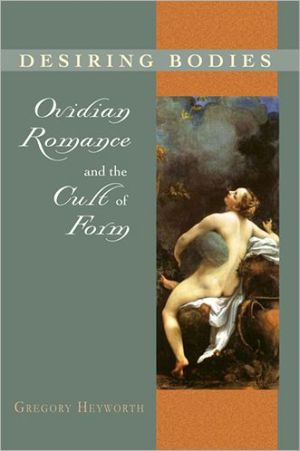

 |

|

The average rating for Desiring Bodies: Ovidian Romance and the Cult of Form based on 2 reviews is 4.5 stars.
Review # 1 was written on 2019-09-27 00:00:00 Lawrence Crowley Lawrence CrowleyFrom the local library. This is a collection of 22 essays on the Arthurian tradition at Glastonbury. Most of it is made of questions about Arthur's burial, but there is a little about Joseph of Arimathea, the name Glastonbury and a few editions of the texts written here. Because it's all made up of essays it has taken me an embarrassing amount of time to read, but I am finally done, and shall stick with happy scholarly books about extinct birds next week. :p (the end of myths?) Yet not even Whiting's martyrdom of the abbey's downfall in 1539 could halt the legend-making process. As a pious colophon, theGlastonbury Thorn which flowered at Christmas time on Werall Hill was transformed into Joseph's flowering staff in the early eighteenth century. The resultant legend related how the travel worn Joseph rested on Wearyall Hill (owing to a folk etymology of Weall), and his knotted staff burst into bloom. Just as St Joseph of Naereth, the foster father ofJesus, was known in ancient tradition by his flowering staff, so undoubtedly it seemed fitting that the alter Joseph, the guardian of Christ's body, should be similarly endowed. The Victorian age also introduced a miracle working fountain known as the Chalice Well, a folk etymology for Chal(c) welle, which, unlike the grtail, could boast of few, if any cures. (Vera historia Arturis is very interesting) The most striking parts of the tale - the mysterious handsome young man with the poisoned lance, the chapel with the narrow entrance and the terrible mist and darkness which descended during the funeral - have their closest parallels in the native Welsh romances, such as the moment in the story of Pryderi where Pryderi and Rhiannon enter a magic caer or fortress and touch a marvellous golden bowl: they are rooted to the spot, unable to speak 'And with that, as soon as it was night, lo, a peal of thunder over them, and a fall of mist, and thereupon the caer vanished, and away with them too. The spear is similar to the poisoned spear with which Gronw Bebyr slew Llew Llaw Gyffes. The adoption of native Welsh story motives into Latin narrative (outside the pages of Geoffrey of Monmouth) (pp110) is not common. The two latin romances which derive more or less directly from welsh material, the Historia Meriadoci and De Ortu Walwanii, would therefore be prima facie candidates for common authorship with the Vera Historia. (Ynys witrin never existed?) By the fifteenth and sixteenth centuries, it would seem that welsh tradition viewed Glastonbury above all as the site of the abbey, the place of pilgrimage perhaps, with Arthurian connections certainly, but more of a Christian holy place than the resting place of the king, Arthur, who would rise again… It should be stressed that during this period the name of the true mab darogan ('the son of prophecy') or returning saviour-king was not Arthur, but Owain, Yvain de Galles (or Owin Lawgoch') Owain Glyndwr and Owain Tudor were identified with this Owain, and the legend was concsiouly manipulated during the fifteenth century with the aim of (p177) securing support for the Tudor dynasty. |
Review # 2 was written on 2012-03-11 00:00:00 London Chapman London ChapmanWords, words, words. Sleep inducing. Not particularly informative. |
CAN'T FIND WHAT YOU'RE LOOKING FOR? CLICK HERE!!!